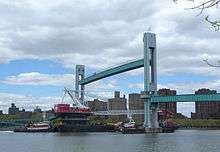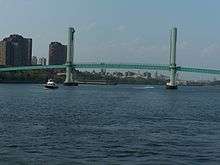Wards Island Bridge
| Wards Island Bridge | |
|---|---|
 "Open" to allow river traffic | |
| Coordinates | 40°47′11″N 73°56′15″W / 40.786293°N 73.937409°WCoordinates: 40°47′11″N 73°56′15″W / 40.786293°N 73.937409°W |
| Carries | Pedestrians |
| Crosses | Harlem River |
| Locale | Manhattan Island and Wards Island, New York |
| Maintained by | New York City Department of Transportation |
| Characteristics | |
| Design | Vertical lift bridge |
| Total length | 1,247 feet (380 m) |
| Width | 12 feet (3.7 m) |
| Longest span | 312 feet (95 m) |
| History | |
| Opened | May 18, 1951 |
The Wards Island Bridge, also known as the 103rd Street Footbridge, is a pedestrian bridge crossing the Harlem River between Manhattan Island and Wards Island in New York City. The vertical lift bridge has a total of twelve spans consisting of steel towers and girders.[1] It carries only pedestrian and bicycle traffic.
On the Manhattan side of the river, the bridge is located at East 103rd Street, between Exits 14 and 15 of the FDR Drive. The bridge is accessible from the East River Greenway and a pedestrian overpass across the FDR Drive to the East River Houses apartment complex in Spanish Harlem. The bridge connects to the southwestern corner of Wards Island and provides access to the many playing fields and scenic waterfront of Randall's Island and Wards Island Parks.
After being closed to the public for approximately two years for a $16.8 million infrastructure project, Wards Island Bridge was reopened on June 1, 2012 and will be open 24 hours-a-day year-round.[2] Previously, the bridge had only been available for use from April through October during daylight hours.
History
The first known bridge to Wards Island was a wooden drawbridge between East 114th Street in Manhattan to the northwest corner of the island. The bridge was built in 1807 to serve a cotton business run by Philip Milledolar and Bartholomew Ward and lasted until 1821, when it was destroyed by a storm.[3]
Pedestrian access to Randalls and Wards Islands was established with the opening of the Triborough Bridge by the Triborough Bridge and Tunnel Authority in 1936. Although plans to construct a separate pedestrian bridge to provide Manhattan residents better access to the new Wards Island Park were developed by Robert Moses in 1937, construction of the bridge did not begin until 1949.[4][5] Designed by Othmar Hermann Ammann and built by the U.S. Army Corps of Engineers,[6] the footbridge was originally known as the Harlem River Pedestrian Bridge.[7]

The Wards Island Bridge opened to pedestrians on May 18, 1951 and was completed at a cost of $2.1 million.[8] The bridge was later opened to bicycles in 1967.[9] Although the bridge was originally painted in a red, yellow, and blue color scheme, it was repainted in sapphire blue and emerald green in 1986.[10]
Restricting access to the bridge during the overnight hours and winter months traces back to concerns from residents of the East River Houses in the 1980s and 1990s over patients from the Manhattan State Psychiatric Center who frequently crossed the bridge into Manhattan. Tenants believed that the patients were responsible for increased levels of crime in their neighborhood.[11]
In 1999, the New York City Department of Transportation proposed that the bridge be converted to a fixed bridge status. However, this proposal was delayed due to the clearance necessary to float construction equipment up the Harlem River for reconstruction projects associated with the Third Avenue, Willis Avenue, and 145th Street Bridges.[12]
The Wards Island Bridge underwent reconstruction between April 2010 and April 2012, which included replacement of the walkway deck, steel superstructure, and electrical and mechanical control systems.[1]
Cultural references

References
- 1 2 "Harlem River Bridges" (PDF). New York City Department of Transportation. 2004. Retrieved 2009-08-08.
- ↑ "NYC DOT Commissioner and Council Member Mark-Viverito Reopen Wards Island Bridge". New York City Department of Transportation.
- ↑ "Wards Island Park Historical Sign". New York City Department of Parks & Recreation. Retrieved 2009-08-08.
- ↑ "Foot Bridge Urged for Wards Island; Moses Wants 790-Foot Span to Link Manhattan to Park Site at 103rd Street". The New York Times. November 8, 1937. Retrieved 2009-08-08.
- ↑ "Bridge to Be Built to Wards Island; Pedestrian Span Across the Harlem Will Open New Park Facilities to East Siders". The New York Times. June 9, 1949. Retrieved 2009-08-08.
- ↑ "NYC Bridges & Tunnels 2009 Annual Report, page 81" (PDF). New York City Department of Transportation.
- ↑ Rastorfer, Darl (2000). Six Bridges: The Legacy of Othmar H. Ammann. Yale University Press. p. 31. ISBN 0-300-08047-6.
- ↑ "Wards Island Footbridge and Park Open; Moses Calls 'Planning Experts' No Help". The New York Times. May 19, 1951. Retrieved 2009-08-08.
- ↑ "Bridge to Wards Island Is Opened to Bicyclists". The New York Times. September 15, 1967. Retrieved 2009-08-08.
- ↑ Anderson, Susan Heller; Prial, Frank J. (September 15, 1986). "For Wards I. Bridge, A Change of Colors". The New York Times. Retrieved 2009-08-08.
- ↑ Carvajal, Doreen (January 8, 1995). "Wards I. Bridge: History of Problems". The New York Times. Retrieved 2009-08-08.
- ↑ "2003 Bridges and Tunnels Annual Condition Report" (PDF). New York City Department of Transportation. 2004: 87. Retrieved 2008-08-08.